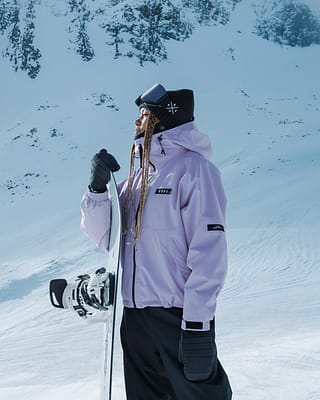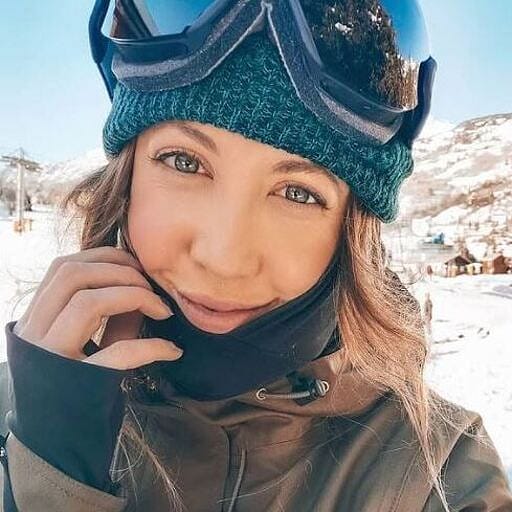8 tips for intermediate snowboarders
Nailed falling leaf and linking your turns? Looking to step up your snowboarding game? We’ve rounded up eight intermediate snowboarding tips to help you ride with more control, style, and confidence.

Yew – you’re falling in love with snowboarding! Turns are feeling smoother, and you’re over the stage of constantly nursing a bruised tailbone. But now, your sights are set on new techniques. So, how do you progress past the basics and ride like a confident intermediate – or beyond? We’re here with eight tips to improve your riding.
Oh, and don’t forget to line up our latest snowboarding collection. We believe if you look good, you feel good – and shred even better. So have a browse and prepare to level up in style and skills.
How to improve your snowboarding technique
Upgrade your setup
Steer your board with both feet
Ride more dynamically
Control your speed
Perfect your turns on steeper terrain
Try riding switch
Experiment with carving
Book a lesson
1. Upgrade your setup
Beginner boards can limit intermediates. So, let’s ditch those and level up! However, as you move to an intermediate board, it’s important to think about where you snowboard most, as this can impact your setup. For example, you might want a shorter board for park, as they’re more agile and easier to move. However, they’re less floaty for freshies. Of course, you can choose an all-mountain board. This is an awesome starting point, as these boards are designed to handle varied terrain.
Unsure which size snowboard to get? Dope Mag’s got you! Just search through our snowboarding articles to find more info (including shapes and camber profiles) and a size chart. You can also chat with staff at your local rental shop and try out a few boards before committing to a specific design.
2. Steer your board with both feet

Let’s leave putting most of your weight on your back foot when turning in newbie territory. Instead, as an intermediate, try using both feet to steer your board in the direction you want to go. You should feel more balanced and confident while your turns become more powerful and controlled. You also avoid any dreaded skidding when turning – a common side effect of weight-bearing on your back foot.
So, what does steering with both feet look like? Well, you initiate your turns by applying pressure to your front foot and pressing your shin against your boot to help pivot the board. Your back foot will follow the same path. Then, as you’re turning, shift your weight so it’s evenly distributed onto both feet. Center your hips, too. It all comes together to boost stability. Dreamy.
3. Ride more dynamically
As you explore more of the mountain, you’ll encounter technical terrain. So, prepare for dynamic riding! This involves bending your knees to absorb all those bumps, dips, and choppier snow. Try to avoid the common problem of riding with your legs too straight and leaning your upper body too much (more obvious on heel-edge turns). Instead, let your lower body and those bent knees lead down the fall line while keeping your head and shoulders still. You’ll experience more power and momentum while preventing those annoying chattery turns.
Don’t forget to center your weight over your board! Just lean your shins forward into the front of your boots, bend your knees, and push your hips forward (or sink them down and lift your toes for a heelside turn). This keeps your back straight and your weight centered over the board, increasing control and stability. More of a visual learner? Check out Snowboard Addiction’s handy how-to video below. Now, you can blast through groomer bumps with confidence and pop better on jumps. As you progress, experiment more with flexing your knees and edge pressure, too.
4. Control your speed
Nothing screams ‘beginner’ more than someone who’s out of control…and then catches an edge and performs a spectacular yard sale. So, know how to control your speed. The best way to do this? Turn, baby! And we don’t mean short, sharp turns. Instead, make wider ones (sometimes referred to as closed turns). These act the same as pumping on the brakes – and soon the runaway shredder becomes calm, collected, and controlled…with fewer face plants.
Of course, you can rely on the trusty traverse. Traversing involves traveling across the slope to slow down rather than build up speed down the fall line. You can also spray snow to slow down or come to a halt. Just push both feet out and away from you to spray the white stuff. Snow spraying is even more epic when there’s fresh pow – you’ll feel like Travis Rice in a slow-mo shot from The Art of Flight.
5. Perfect your turns on steeper terrain

A little freaked on steeper terrain? Bend your front leg so your body matches the slope's steepness, and have your hips and shoulders in line with your board and the terrain angle. Then, over-exaggerate the lean. If it feels unnatural at first, you’re probably doing it right. Still struggling to get forward? At the start of each turn, bend down and touch your boot or front knee with your front hand.
Although your board shifts from edge to edge underneath, you don’t want your upper and lower body to be massively out of sync (known as counter-rotating turns). Instead, have your upper and lower body rotate in the same direction for better balance and stability. Then, point your hips and board across the fall line at the end of your turn to avoid gaining too much speed. Even advanced riders sometimes revert to basics like sideslipping when needed. Confidence comes with knowing when to use every tool you’ve got. Do whatever makes you feel safest and confident to get down (hopefully, still smiling).
6. Try riding switch
Riding switch involves having your less-dominant leg in front – basically, the opposite of your natural stance. Doing this is rad for intermediates, as it makes you feel you’re starting from scratch again (in the best way!) and significantly improves balance and stability. Knowing how to shred with your other leg forward also preps you for riding park and unleashing your inner jibber. With switch in your skill set, you can land in a different direction from takeoff (such as when nailing 180s) and ride toward or away from features.
Take yourself back to the bunny hill to practice your toe-edge and heel-edge turns riding switch. Then, apply all our above tips to your non-dominant leg, such as bending your knees and steering with both feet. You’ll most likely feel weird when trying switch. Don’t worry – that’s totally normal! And it won’t be long until the unnatural stance feels second nature.
7. Experiment with carving

Carving is about digging your edges into the snow as you turn. For a toeside turn, bend your knees and ankles and tip your board onto its edge, applying pressure with your toes to grip the snow. For a heelside turn, tip the board onto its back edge by squatting, lifting your toes, and pushing through your heels. Then, move between heelside to toeside turns, leaning right over with your upper body and drawing a smooth, thin line with your board edge.
Seeing a true carver in motion is like witnessing a work of art. Okay, it’s a pretty advanced skill. However, intermediates are at the perfect point to play, experiment, and move beyond beginner skidded rotations to more stylish carved turns. Remember that carving helps you accelerate speed. So, only move on to this step once you’re comfortable with speed control.
8. Book a lesson
We say there’s always more to learn! So, why not book yourself a lesson? And, no, that doesn’t mean going back to basics and rubbing shoulders with total beginners. Instead, most ski resorts have intermediate-focused lessons, clinics, and camps. And they’re specifically designed to refine where you’re currently at, stop any bad habits from forming, and learn new skills.
And when you’re not in lessons? Ride with people better than you! It’s the best way to pick up pointers and gain confidence. Watching pros at play also really helps. Yep, open YouTube, Instagram, or TikTok and soak up the style of snowboarding legends such as Shaun White, Anna Gasser, Mark McMorris, and Chloe Kim. Then, when you’re next on snow, visualize and emulate their moves. Oh, and have someone in your crew film you! It’s the best way to see where you can tweak your style and enhance those skills.
Wrapping up
We bet you’re now itching to get out there and have a go. We have one more tip for you, though – have fun! Yep, it’s easy to beat yourself if you don’t nail our eight tips the first time. However, learning is an ongoing process. So, be patient with yourself and laugh at the slams and not-quite-there attempts. It sounds mega cheesy, but practice really does make perfect – and, in the meantime, it’s always super fun just being on snow, right?
Have another tip that you think snowboarders should know about? Shoot us an email at crew@dopesnow.com. We’d love to hear them and can even expand our list!
Related reading:


